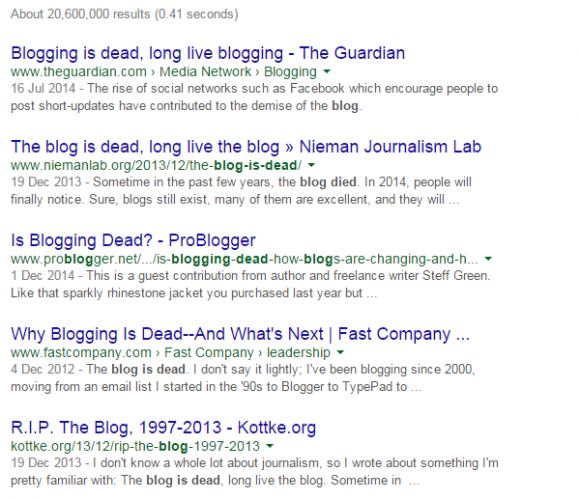4 Ways to Ensure Readers Trust Your Business Blog
Editor’s note: This post was written by Seb Atkinson, a search marketer at Selesti, a multi-award winning creative digital agency. Seb has helped a range of clients grow their online presence, from start-ups and small businesses to large international corporations. Follow him on Twitter.
One of the biggest reasons for having a blog on your company’s website is that well written, insightful posts can really help build credibility for your business, positioning your company as a leader in its field. But in order to achieve this, it’s important you ensure that building trust and credibility is part of your content creation process, as well as including all the right trust signals on your blog’s pages. In this article, we’ll discuss some ways you can ensure your readers trust your blog, and by extension, your business, leading to better brand awareness and increased sales.
Ensure articles live up to the promises made in their titles
The first thing you need to consider in order to build trust with your readers is to ensure that this is something you’ve considered throughout your content creation process. A good starting point is to ensure all your articles deliver on the promise they make in their titles. Everything you say about your brand is a promise – you promise to provide something of value, while your readers promise to engage with you as a result.
One technique that is beginning to wear thin with readers – both business and consumer – is the click bait headline. While it is important to write a title that compels readers to click, especially for social media traffic, it is essential that the title does not make promises you can’t meet, for example using a sensationalist or misleading title. As Helen Nesterenko explains, misleading click bait titles can associate your brand with zero quality content while raising your readers’ expectations unrealistically, leading to a big let-down once they read your article.
The click bait technique is not just limited to consumers and gossip sites, it also rears its head on business blogs, for example numerous sites claiming the death of business tools like SEO or blogging, which then go on to conclude that the tool or process is ‘here to stay’ – not exactly delivering on the title’s promise.
Others offer titles like ‘Three Proven Steps To Double Your Sales’, which then fail to offer cite any freely accessible resources that actually prove these techniques worked, or which can’t easily be replicated.
This can really be a turn off for readers for any kind of content, including blogs and PDF downloads. In a recent study, 71% of B2B buyers were disappointed by the content downloaded from a business, with 25% of those claiming they would never read content from that business again as a result of their disappointment.
Using Case Studies to Prove Points
An easy way to ensure your articles live up to the promises made in their titles is to use case studies to prove points. As Lewis Crutch explains, case studies help your blog content appeal to different types of readers – some readers simply want answers to problems, some want reassurance that the answers presented are correct, while others want to see that others have faced the same challenges and succeeded.
However, the most important reason for supporting any answers to your customers’ problems with a case study is to differentiate yourself from those out there looking to make a quick buck. Anyone can claim that their products or services solve common customer problems. Meanwhile, a case study shows exactly why your products or services work – similar to showing your working when doing an equation.
Use Offline Trust Signals
Many businesses use their blogs to help them generate new web traffic, leading to increased sales. To achieve sales however, it’s important that your blog also helps to build trust for your services. On top of your own evidence in the form of case studies, it’s beneficial in almost all industries to show you are certified to provide high quality services and products. Many businesses already have this in the form of ISO 9001 certification, though few businesses actively showcase this on their blogs, potentially missing out on sales. A recent survey revealed that as a result of gaining ISO 9001 certification, organisations experienced a significant increase in sales.
Therefore, it’s a good idea to ensure your ISO certification badge is visible across your site – something that is often omitted when your business blog is hosted on a sub domain or different CMS system – as well as mentioning your certification when relevant, for example when it made the difference between meeting a client’s expectations in case studies.
Citing Industry Experts and Publically Accessible Studies
There are likely many articles you could write that make certain points which cannot be proven with your own evidence, for example if your business is relatively new or if you simply don’t have the time to write hundreds of case studies. In this instance, the best thing to do is to cite leading industry experts and publically accessible studies to back up points.
Both these options help to build trust with your audience – as well as protecting you from copyright infringements – as they present stories of others who have seen the same results using similar services or methods to what you offer. Similarly, using freely available reports and statistics is a great way to show your knowledge about your reader’s market, demonstrating your understand their pain points and can offer a viable solution. For example, this article mentions a CBI report to back up a claim made about the construction industry, helping the blog post connect better with readers in that sector.
Meanwhile, this article cites other industry experts to show that the conclusions made have been derived out of research around the subject, again, helping to build trust with the reader and verifying that the points made are legitimate, rather than a sales ploy.
Wrapping Up
As you have seen, there are some simple ways you can ensure your business blog builds trust with readers, covering both the content itself and the presentation of your articles. Ultimately, ensuring you consider how your blog helps to build trust with the reader at every stage ensures your content can stand out among the countless other blogs in your niche, helping to establish you as an authority.



